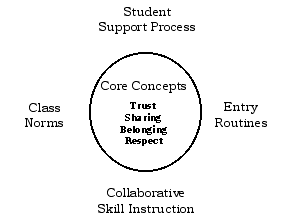|
As depicted below the major components of the supportive classroom
model are: the core concepts of trust, sharing, belonging and respect;
class norms; collaborative skill instruction; entry routines; and
a student support process.

In supportive classrooms
• The core concepts of trust, sharing, belonging and respect
are taught, modeled and practiced throughout the school day.
• Classroom norms (e.g., cooperate and help each other; respect
self/others/property) are developed jointly by students and instructors
to provide a general set of behavior expectations that support the
core concepts of trust, sharing, belonging and respect.
• Collaborative skill instruction and practice on skills that
support the class norms are integrated into activities throughout
the day.
• Entry routines are used to promote a sense of recognition
and belonging, prepare students to concentrate on learning, and
facilitate positive transitions from home to school and between
activities or classes.
• A student support process is used to develop Success Plans
for each student based upon their strengths, interests and needs.
For students who present intensive behavior or learning challenges
positive behavior plans and/or activity inclusion plans are also
developed to maximize their participation in classroom and other
school and community activities.
|



